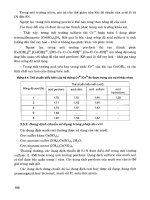dohrmann Episode 1 Part 8 pot
Bạn đang xem bản rút gọn của tài liệu. Xem và tải ngay bản đầy đủ của tài liệu tại đây (204.83 KB, 10 trang )
to those obtained using existing methods based on master-slave concepts for connecting two
meshes.
5. Conclusions
A transition element for meshes containing uniform strain hexahedral and tetrahedral
elements is presented.
Meshes containing the transition element satisfy first-order patch
tests and converge for second-order patch tests under mesh refinement. Comparisons with all-
hexahedral meshes show that mixed-element meshes do not cause any significant degradation
in accuracy. convergence rates or locking behavior for a variety of problems. Guidelines are
established for cxt ending the present approach to higher-order elements and for connecting
dissimilar finite element meshes at a shared boundary.
References
1. D. P. Flanagan and T. Belytschko, ‘A Uniform Strain Hexahedron and Quadrilateral
wit h Orthogonal Hourglass Control’, International Journal for Numerical Methods in
Engmecmng. 17, 679-706 (1981).
2. C. R. Dohrmann, S. W. Key, M. W. Heinstein and J. Jung, ‘A Least Squares Approach
for Uniform Strain Triangular and Tetrahedral Finite Elements’, International Journal
for :Yumcrzcal Methods in Engineering, 42, 1181-1197 (1998).
3. S. \\’.Key. \l. W. Heinstein, C. M. Stone, F. J. Mello, M. L. Blanford and K. G. Budge,
A Suitable Low-Order, 8-Node Tetrahedral Finite Element for Solids’, to appear in
Intemlat~onal Journal for Numerical Methods in Engineering.
4. S. J. Owen. S. A. Canann and S. Saigal, ‘Pyramid Elements for Maintaining Tetrahe
dra to Hexahedra Conformability’,
Trends in Unstructured Mesh Generation, AMD-
Vol. 220 ASME; 123-129 (1997).
5. K. \f. Heal. hf. L. Hansen and K. M. Rickard, Maple V Learning Guide, Springer, New
York. Sew York, 1996.
6. 0. C. Zienkiewicz and R. L. Taylor, The Finite Element Method, Vol. 1, 4th Ed.,
McGraw Hill, New York, New York, 1989.
7. C. R. Dohrmann, S. W. Key and M. W. Heinstein, ‘A Method for Connecting Dissimilar
Finite Element Meshes in Two Dimensions’, submitted to International Journal for
Numerical methods in Engineering.
12
Table 1: Example 1 strain energies for meshes 3m, 6m, 9m and 9h.
v
0.0
0.1
0.2
0.3
0.4
0.499
0.4999
0.49999
9h
3m
6m 9m
exact
Edev
278
306
333
361
389
416
417
417
E.Ol
139
111
83.3
55.6
27.8
0.27
2.78e-2
2.78e-3
Edev
302
332
362
393
423
454
454
454
E.ol
150
121
90.9
60.9
30.6
0.308
3.07e-2
3.07e-3
Edev
283
312
340
369
397
425
426
426
EVOl
142
113
85.2
56.9
28.5
0.285
2.85e2
2.85e-3
Edev
280
308
336
364
393
420
421
421
E.ol
140
112
84,2
56.1
28.1
0.281
2.81e-2
2.81e-3
Edev
280
308
336
364
393
420
421
421
E.Ol
140
112
84.2
56.1
28.1
0.281
2.81e-2
2.81e-3
Table 2: Example 2 strain energies for meshes 3m, 6m, 9m and 9h.
v
3m
6m 9m
m
ma=
0.1
1029
0.2 944
0.3 871
0.4 809
0.499
755
0.4999
755
0.49999 755
0.09
0.09
0.11
0.17
14
1.4e2
1.4e3
1043
956
882
819
765
765
765
u
0.02 1045 0.01
0.02 958 0.01
0.02 884 0.01
0.01 821 0.003
0.04 767 0.02
0.18 767 0.06
0.10 767 0.03
1045
958
884
821
767
767
767
0
0
0
0
0
0
0
1047
960
886
823
769
768
768
Table 3: Example 3 strain energies for meshes 3m and 3h.
3h
v
3m
E.Ol
0.0835
0.0908
0.105
0.136
0.232
4.62
1.83
2.13
16.2
EVO1
0.0174
0.0208
0.0262
0.0359
0.0621
3.28
21.4
117
854
.&ev
1132
1029
944
871
809
760
769
772
773
Edev
1132
1029
943
871
809
756
759
794
863
0.0
0.1
0.2
0.3
0.4
0.499
0.4999
0.49999
0.499999
13
8
5
3
1
2
Figure 1: Sketch of polyhedron showing 12 of the 24 triangularfaces.
3
Figure 2: Connecting face of transitionelement.
15
Figure 3: Element geometry of uniform strain tetrahedron.
16
Figure 4: Mesh 6m with 12 transition elements and 92 hexahedral elements removed.
2
1.8
1.6
1.4
1.2
1
0.8’
-2.2
I I I
I 1
1
x
x
mixed–element meshes
❑
H
all-hexahedral meshes
-2 -1.8 -1.6
-1.4
log(lln)
–1 .2
-1 -0.8
Figure 5: Energy norm of the error for Example 1 (v= 0.3).
2
I.8
1.6
1.4
1.2
1
O.E
-:
I
I
I [ I #
x x
mixed–element meshes
Q
❑
all–hexahedral meshes
)
-2 -1.8 -1.6 –1.4
-1.2 -1 -0.8
log(lln)
Figure 6: Energy norm of the error for Example 1
(v= 0.4999).
m
1.6
1.4
1.2
1
0.8
0.6
0.4
o.~
~
-2 -1.8
-1.6 –1.4 -1.2
-1
-0.8
log(lhz)
Figure 7: Energy norm of the error for Example 2
(v = 0.3).
20
-??.2
-2 -1.8
-1.6
-1.4
-1.2
-1 -0.8
Iog(lln)
Figure 8: Energy nom of the error for Example 2 (v = 0.4999).
21









